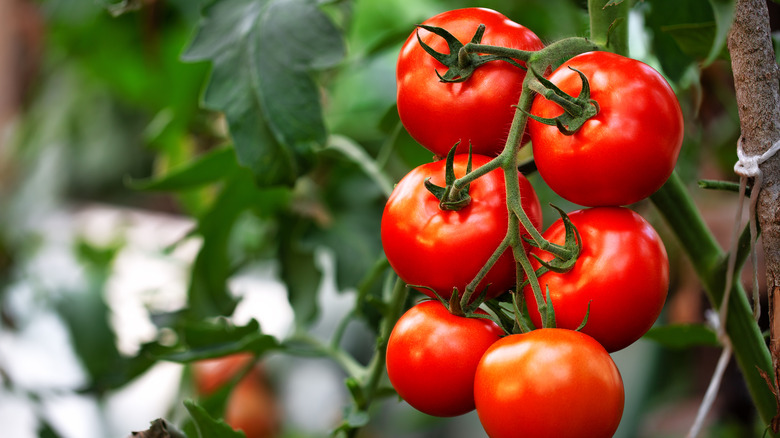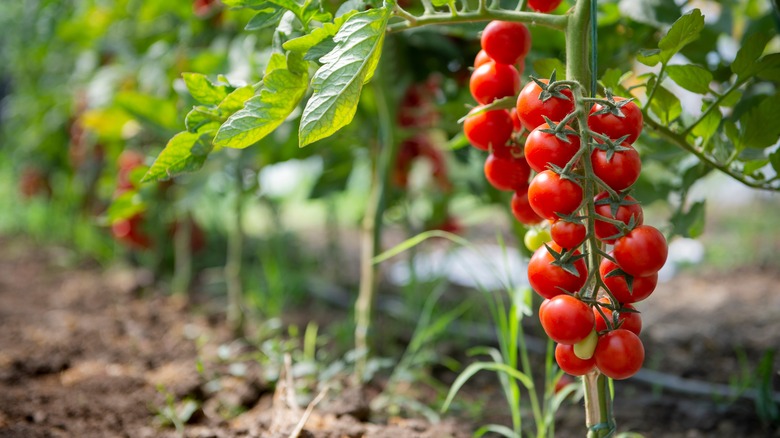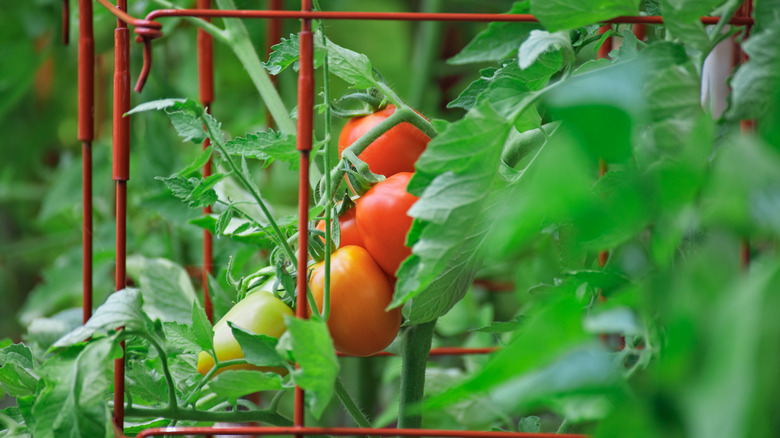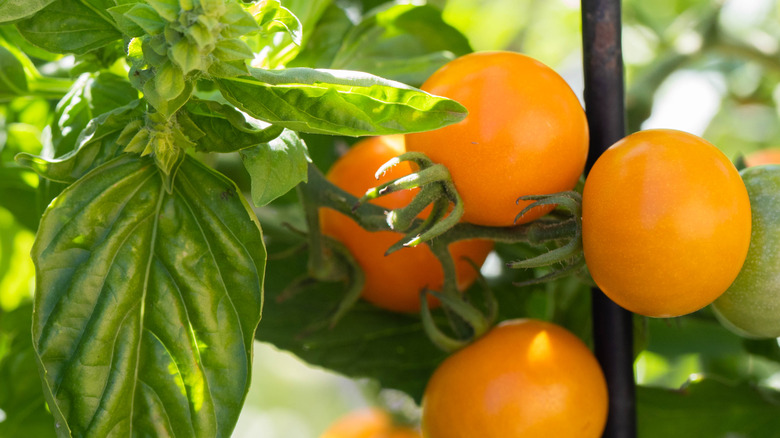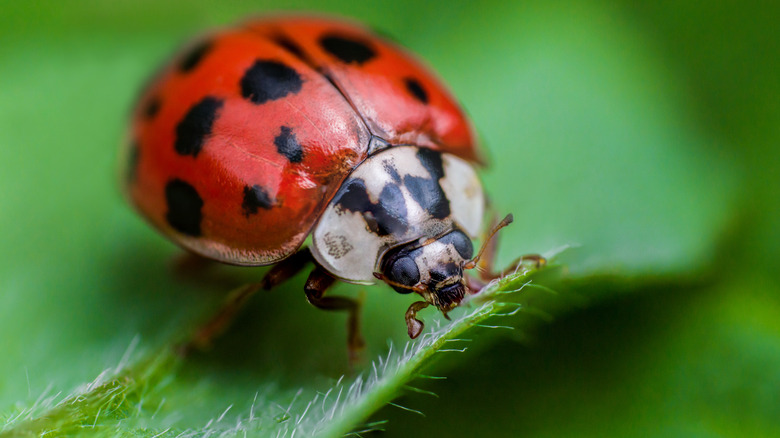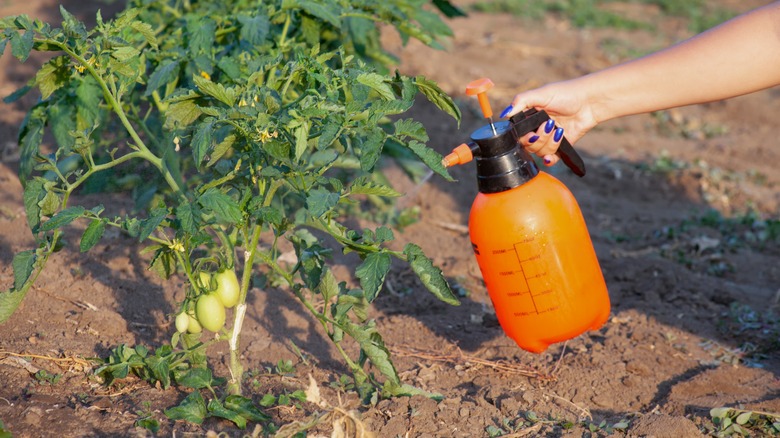5 Tips For Keeping Bugs Off Your Tomato Plants
Tomatoes are one of the most versatile and well-loved crops, used in a variety of dishes in cuisines around the globe. That hasn't always been the case, though. According to Vegetable Facts, the acidic fruit, or vegetable, depending on how you classify it, was domesticated in 500 B.C.E. by the Aztecs and used as food and a hallucinogen. European countries were very hesitant to incorporate tomatoes into their cuisine for various reasons, including not knowing how to properly manage the crop and fearing sickness from eating the toxic parts, such as the leaves.
Now, though, tomatoes are the most popular crop and vegetable in the United States, with 93% of gardeners growing tomato plants in their yards. Tomatoes aren't just popular amongst gardeners, though. While tomatoes are generally relatively easy to grow and maintain, they aren't invulnerable to gardening headaches, such as pests and bugs. Keep reading to learn how to protect your tomato plants from pesky bugs.
1. Space them properly
The most effective pest repellent is to prevent an infestation in the first place without the use of pesticides. This involves appropriately planting and spacing your tomatoes to minimize pests overall. Tomato Bible points out that tomatoes cultivated too close together will have denser leaves, and the resulting darkness and moisture will harbor many hidden pests. It will also restrict airflow, which increases the chance of a full-blown infestation. So, before planting your tomato seeds or plants, ensure you know how to distance them properly. Unfortunately, there isn't a catch-all answer, but recommendations are based on your tomato type.
According to Iowa State University Extension and Outreach, there are two types of tomatoes: determinate and indeterminate. Determinate tomatoes have a predetermined height they'll grow to, at which point they will quickly produce crops and die. These tomatoes should be planted at least 2 feet apart, with rows spaced 4 feet away. Indeterminate tomatoes, on the other hand, don't have a set height or time to yield crops. Instead, they will grow and produce crops until the season's first frost. These tomatoes should be planted at least 1.5 feet apart, roughly 4 feet between rows. If they're being grown in a cage, place them at least 2.5 feet apart.
2. Tomato cages
While they aren't technically necessary, tomato cages are vital to the plant. Tomato cages are made of wire that allows the tomato plant to vine up, keeping the crops off the ground and allowing the plant to grow taller and healthier, per Reviewed. Keeping the budding tomato fruit off the ground is beneficial for various reasons, including making it easier and more accessible when it comes to harvest and keeping them away from bugs and other garden pests.
When grown without wire restraints — be it a cage, trellis, or cone — tomatoes will fold under their weight, and the budding fruit will likely rot before you can harvest. If they don't rot, bugs will be attracted to the unprotected crop and most likely infest it. Lifting them off the ground won't deter flies, but it will keep the fruit from being a breeding ground for even more bugs. When purchasing your tomatoes, whether seeds or a small, pre-grown plant, check how tall they should grow. This will help you determine the cage size and width you will need. Larger species require more extensive, heavier cages, whereas more diminutive varieties need thinner and smaller ones.
3. Companion plants
Most beginner gardeners will likely start with at least one tomato plant. If you're up to the challenge, consider adding a few additional herbs or flowers nearby to keep your tomato plants pest-free. These are referred to as companion plants, and they have two purposes — to keep harmful pests and insects away and attract helpful critters, per Tomato Dirt.
Beginning with plants that repel harmful insects, there are a variety of flowers, vegetables, and fruits you can incorporate into your garden. Some of the most effective include mint and chives, nasturtiums, marigolds, geraniums, and collard greens and cabbage. For attracting helpful pests, add in some parsley and borage. A particularly excellent companion plant that does both is basil, and you can plant them near your tomatoes. If you have limited space, consider just getting a flower basket containing one of the previously mentioned plants and placing it nearby.
4. Ladybugs
While finding bugs in your garden is an unpleasant experience, a few friendlier insects are a much more welcome sight. One of the most beneficial garden insects is the bright red ladybug, which is much more interested in the aphids and spider mites on your tomato plants than the fruit, via Mega Tomato.
Per Organic Lesson, some plants are desirable to the lucky ladybug, including marigolds, cosmos, and calendulas. However, there are other ways to get ladybugs into your garden, including building a ladybug house (a small enclosed habitat for them to find shelter). You can also purchase live ladybugs and release them into your garden if you don't mind handling the insects. According to Rural Sprout, you should ideally release them on a cool, rainy, or otherwise damp day. You can typically find live ladybugs at garden centers during spring, summer, and fall and through online retailers.
5. Sprays and pesticides
While there are plenty of natural ways to repel insects from your tomatoes, likely, they won't be strong enough to keep away persistent bagworms, aphids, spider mites, etc. It may be time to turn to chemical or homemade insecticides in this situation. If you want to go the chemical route, Our Garden Works suggests looking for a pesticide with Pyrethrin, which kills a host of common tomato pests.
Numerous DIY organic sprays can help keep harmful insects away from your tomato plants. One very popular method involves using chili powder. While people have unique spice preferences, bugs almost universally hate anything spicy and tend to avoid it. Mix chili powder, dish soap, and water in a spray bottle, and either spray down your entire plant or use it to spot and kill individual bugs. You can also mix cayenne, garlic, and onion powder in water and use it the same way. Other ingredients to make a spray solution include vinegar, hydrogen peroxide, baking soda, dish soap, and rhubarb leaves.
